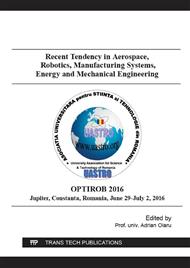[1]
Chr. Pelecudi, Bases of Mechanisms Analysis, Editura Academiei Române, Bucharest, (1967).
Google Scholar
[2]
N.I. Manolescu, Fr. Kovacs, A. Oranescu, Teoria mecanismelor si a masinilor, Editura didactica si Pedagogica, Buchaarest, (1972).
Google Scholar
[3]
B. Siciliano, O. Khatib, Springer Handbook of Robotics, Springer-Verlag New York, (2008).
Google Scholar
[4]
N. Rojas, F. Thomas, On closed-form solutions to the position analysis of Baranov trusses, Mechanism and Machine Theory, vol. 50, pp.179-196, (2012).
DOI: 10.1016/j.mechmachtheory.2011.10.010
Google Scholar
[5]
B. Parrish, J.M. McCarthy, Identification of a usable six-bar linkage for dimensional synthesis, New trends in Mechanism and Machine Science, Springer, Dordrecht, (2013).
DOI: 10.1007/978-94-007-4902-3_27
Google Scholar
[6]
F. Penunuri, R. Peon-Escalante, C. Villanueva, D. Pech-oy, Synthesis of mechanisms for single and hybrid tasks using differential evolution, Mechanism and Machine Theory, vol. 46, no. 10, pp.1335-1349, (2011).
DOI: 10.1016/j.mechmachtheory.2011.05.013
Google Scholar
[7]
M. Plecnik, J.M. McCarthy, Dimensional synthesis of six-bar linkages as a constrained RPR chain, New trends in Mechanism and Machine Science, Springer Netherlands, pp.273-280, (2013).
DOI: 10.1007/978-94-007-4902-3_29
Google Scholar
[8]
M. Plecnik, J.M. McCarthy, Computational design of Stephenson II six-bar function generators for 11 points, under review for the ASME Journal of Mechanisms and Robots, (2015).
DOI: 10.1115/1.4031124
Google Scholar
[9]
M. Plecnik, J.M. McCarthy, Design of Stephenson Linkages that guide a point along a specified trajectory, preprint submitted to Mechanism and Machine Theory, April 27, (2015).
DOI: 10.1016/j.mechmachtheory.2015.08.015
Google Scholar
[10]
Adr. Comănescu, D. Comănescu, I. Dugăeşescu, L Ungureanu, Optimal inverse models for bi-mobile mechanisms of walking robot legs, DAAAMinternational Scientific Book 2013, vol. 12, pp.417-430, Publisher DAAAM International Vienna, ISBN 978-3-901509-94-0, (2013).
DOI: 10.2507/daaam.scibook.2013.21
Google Scholar
[11]
Adr. Comănescu, D. Comănescu, I. Dugăeşescu, L Ungureanu, C. Alionte, Classical modules applied to the mechanisms structural analysis and synthesis, 14th World Congress in Mechanism and Machine Science, Taipei, Taiwan, 25-30 October, (2015).
Google Scholar


